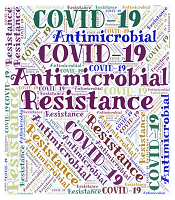Dear editor,
In December 2019, Coronavirus disease 2019 (COVID-19) emerged in Wuhan, China, and spread all around the world in only a few weeks with a fatality rate of 2%. High transmission rate, besides fast infection onset, has raised a global concern against this virus. However, no vaccine or treatment has been found for this disease at present (1). The current outbreak of COVID-19 has turned most of us into germaphobes that rarely leave the house without having our bottle of hand sanitizer. For many years, hand sanitizers have gained our trust as destroyers of all microbes. However, it is better to be more cautious and think of their possible consequences before occurrence. Triclosan is a broad-spectrum antibacterial agent with bacteriostatic effects at low concentrations and has bactericidal effects at high concentrations. It is one of the ingredients previously used in some hand sanitizers. A study published in 2018 has shown that the triclosan in hand sanitizers just accelerates resistance to antibiotics in Escherichia coli only with 30 days of exposure to 0.2mg/L triclosan (2). Also, Staphylococcus aureus, as one of the potentially harmful bacteria of skin in humans seems to show resistance against antimicrobial agents as a result of exposure to triclosan (3). Active efflux is a resistance mechanism, involving reducing the drug concentration in bacteria, and after the long-term use of triclosan, this system drives the intracellular antibacterials out of the cell and causes resistance to triclosan and other antimicrobial drugs (4, 5). Triclosan and so many other ingredients were banned by the FDA in hand sanitizers; however, the exact impacts of other remaining ingredients are not clear and need time to be proven (6). Antimicrobial resistance is an important global health concern. According to the Centers for Disease Control and Prevention (CDC), antibiotic-resistant bacteria infect about 2.8 million people and result in more than 35,000 deaths annually in the United States (7). It is also important to notice that repeated use of alcohol-based hand sanitizers can cause skin dryness and makes it difficult to heal when injured. Besides, alcohol can kill the skin microbiome that consists of trillions of beneficial bacteria, viruses, and fungi. The skin microbiome acts as a natural defense against different pathogens and its breakdown may result in the development of chronic disease in the future (8). These outcomes together may build an even bigger threat, besides or after the coronavirus pandemic. Taking the current COVID-19 pandemic into consideration, using hand sanitizers is inevitable; but to avoid their important consequences, including antimicrobial resistance, some steps need to be taken. For instance, due to unclear aspects of ingredients in hand sanitizers, it may be better to limit their usage to places with higher rates of infection, including hospitals and health care centers. Finally, it is important to keep in mind that hand sanitizers carry zero advantages comparing to washing soaps, and it may be better for everyone's safety to replace them with soaps for daily usage.
